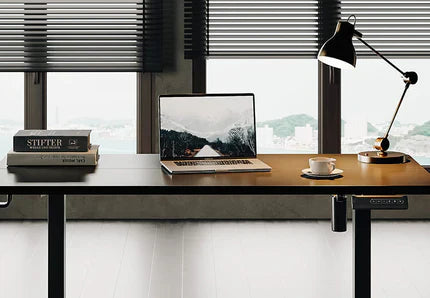Setting up your standing desk at the right height is key to working comfortably and safely. A poorly adjusted desk can cause neck and back pain and make it harder to work effectively - even if you've bought a good quality desk. The best height for your desk depends on how tall you are, what you're doing, and what shoes you're wearing. When your desk is at the right height, you'll be able to work with good posture and focus on your tasks without physical strain. Let's look at how to adjust your desk correctly.
Common Standing Desk Setup Mistakes to Avoid
Even a high-end standing desk won't help if it's not set up properly. Three major setup mistakes often cause discomfort and reduce the benefits of standing while working.
Setting Your Desk at the Wrong Height
A desk that's too high forces you to raise your shoulders and bend your wrists upward to type, leading to shoulder and neck tension. When it's too low, you hunch forward and strain your back. Your elbows should bend at 90 degrees with your wrists straight - if not, adjust your desk height.
Not Accounting for Your Body Type
Body proportions matter more than overall height. Someone who is 5'8" with long arms needs a different desk height than someone of the same height with shorter arms. Pay attention to your arm length, torso height, and leg length when setting up your desk. These individual differences affect your ideal desk height more than general height guidelines.
Forgetting to Adjust for Different Tasks
Many people set their desk height once and never change it. Different tasks often require different heights - typing height might not be ideal for writing by hand or reading physical documents. Your desk height should adapt to your various work activities throughout the day.

What Is a Good Standing Desk Height?
A good standing desk height positions your keyboard at elbow level, typically between 38-44 inches from the floor for most adults. The exact measurement depends on your height, shoes, and the tasks you do at your desk.
The 90-Degree Elbow Rule
Your arms tell you a lot about whether your desk is at the right height. Stand naturally with your arms at your sides, then bend your elbows to 90 degrees. Your forearms should be parallel to the floor - this is where your keyboard should rest. If you need to raise your shoulders or bend your wrists up or down to type, adjust your desk height until your arms feel relaxed and natural.
Monitor Setup for Comfortable Viewing
Place your monitor so the top third of the screen lines up with your eye level. Keep the screen about an arm's length away from you - roughly 20-24 inches. Your neck should stay straight, not bent up or down. If you wear bifocals, you might need to lower your monitor slightly to avoid tilting your head back.
Quick Height Guidelines and Calculations
Most people find comfort with a desk height between 38 and 44 inches. For a quick estimate of your ideal desk height, use this simple math:
- Take your height in inches
- Multiply it by 0.6
- Add 30 to the result
For example: If you're 5'8" (68 inches):
- 68 × 0.6 = 40.8
- 40.8 + 30 = 70.8 inches desk height
Don't forget to factor in your shoes - a pair of running shoes adds about an inch, while dress shoes might add more. Adjust your desk height accordingly when you switch footwear.
Equipment That Affects Your Standing Desk Setup
The tools and accessories you use can significantly change how you set up the adjustable standing desk height. Here's what to consider with each piece of equipment.
Keyboard Tray Impact
A keyboard tray typically sits 3-4 inches below your desk surface, which means you'll need to set your desk slightly higher than normal. The tray should allow your forearms to remain parallel to the floor while typing.
Monitor Stand Adjustability
An adjustable monitor stand gives you more control over screen height independent of desk height. This separation helps you maintain proper posture - you can keep your keyboard at elbow height while positioning your screen at eye level.
Anti-Fatigue Mat Considerations
These mats can add half an inch to two inches to your standing height. You need to factor in this extra height when adjusting your desk, especially if you switch between using the mat and standing directly on the floor.

How to Tell If Your Standing Desk Height Is Right
Your body gives clear signals about whether your standing desk is at the correct height. These physical indicators help you fine-tune your desk setup.
Signs of Proper Desk Height
- Your shoulders stay relaxed and down, not hunched or raised
- Your wrists remain straight while typing, not bent up or down
- Your neck stays in line with your spine, not tilted forward or back
- Your elbows form a 90-degree angle when typing
- Your head faces forward naturally, not angled toward the screen
Warning Signs to Watch For
Your desk height needs adjustment if you notice:
- Shoulder tension or neck stiffness
- Wrist pain or tingling in your fingers
- Lower back ache
- Constant shifting or leaning forward
- Feeling like you're reaching up or down to type
Getting Used to Your Standing Desk
The first week with an adjustable standing desk might feel uncomfortable - this is normal. Start with 15-20 minute standing periods and gradually increase the duration. Most people adapt within 1-2 weeks, but listen to your body and adjust your standing time accordingly. If discomfort persists beyond two weeks, double-check your desk height and equipment setup.
Daily Standing Desk Habits for Better Health
Good standing desk habits help prevent fatigue and maximize the benefits of your workspace. These practical tips make standing while working more comfortable and sustainable.
Build Up to 60-Minute Sessions
Start with just 15-20 minutes of standing work twice a day in your first week. Each week, add 5-10 minutes to your standing time. Most people can comfortably stand for up to 60 minutes after 2-3 weeks of practice. If you feel tired, it's perfectly fine to sit down before your planned standing time ends.
Move While You Stand
Your comfort needs change throughout the day as you work. Avoid standing completely still - shift your weight between legs, take small steps in place, or rock gently while you work. These small movements help your circulation and reduce muscle fatigue. A good work routine mixes both sitting and standing positions.
Check Your Desk Height Daily
Different shoes and activities affect your ideal desk height. Check and adjust your desk height at the start of each standing session, especially when you switch between sitting and standing. Even a half-inch adjustment can make a big difference in comfort. Make small changes to your desk height if you feel any strain in your neck, shoulders, or wrists.
Adjust Your Standing Desk Height Right!
A good adjustable standing desk makes a big difference in your workday comfort. Keep your elbows at 90 degrees, your monitor at eye level, and your wrists straight to prevent strain. Start with short standing periods and adjust your desk height when you change shoes or tasks. With proper setup and a few weeks of practice, you'll find yourself working comfortably while standing.
FAQs about Standing Desk Height
Is 75 cm too high for a desk?
For most people, 75 cm (29.5 inches) is too low for a standing desk. A good standing desk height typically ranges from 96-112 cm (38-44 inches). Check your own height using the 90-degree elbow rule: when standing, your forearms should be parallel to the desk surface with elbows bent at 90 degrees.
How high should a standing desk be in centimeters?
Most standing desks should be between 96-112 cm (38-44 inches) high. To find your exact height, multiply your height in centimeters by 0.6 and add 76 cm (30 inches). For example, if you're 170 cm tall: (170 × 0.6) + 76 = 178 cm desk height. You can adjust this based on your shoes and equipment.
What height should a monitor be for a standing desk?
Position your monitor so the top third of the screen aligns with your eye level, typically 50-75 cm (20-30 inches) above your desk surface. Keep the screen about an arm's length away (50-60 cm). Use an adjustable monitor stand to find the right height independent of your desk height.
What is a healthy desk height?
A healthy desk height positions your keyboard at elbow level with your arms bent at 90 degrees. For most adults, this means 96-112 cm (38-44 inches) from the floor. The exact height depends on your body proportions, shoes, and equipment like keyboard trays or anti-fatigue mats. Check for comfort signs: relaxed shoulders, straight wrists, and a neutral neck position.




Share:
How to Maximize Space with a Wall-Mounted Monitor Arm
The Benefits of Using a Standing Desk for Your Health and Productivity